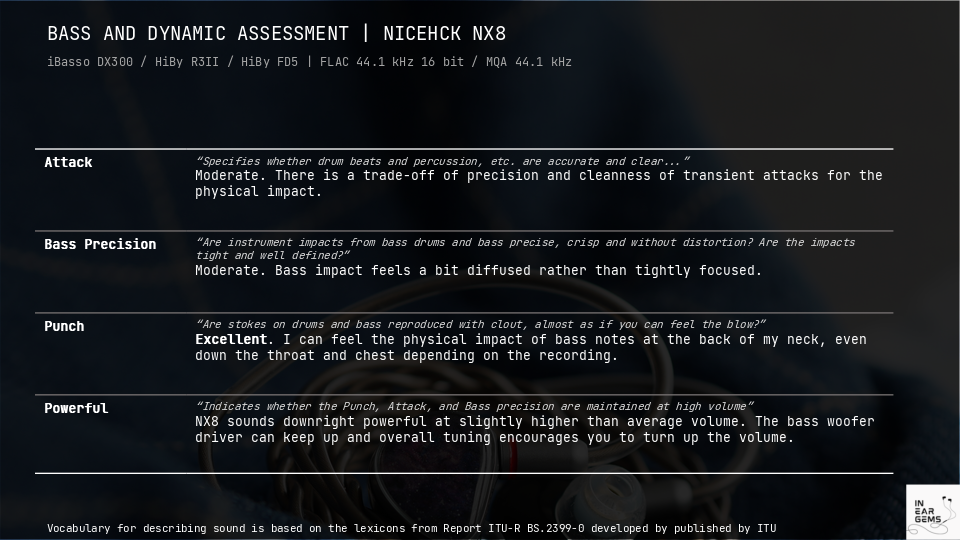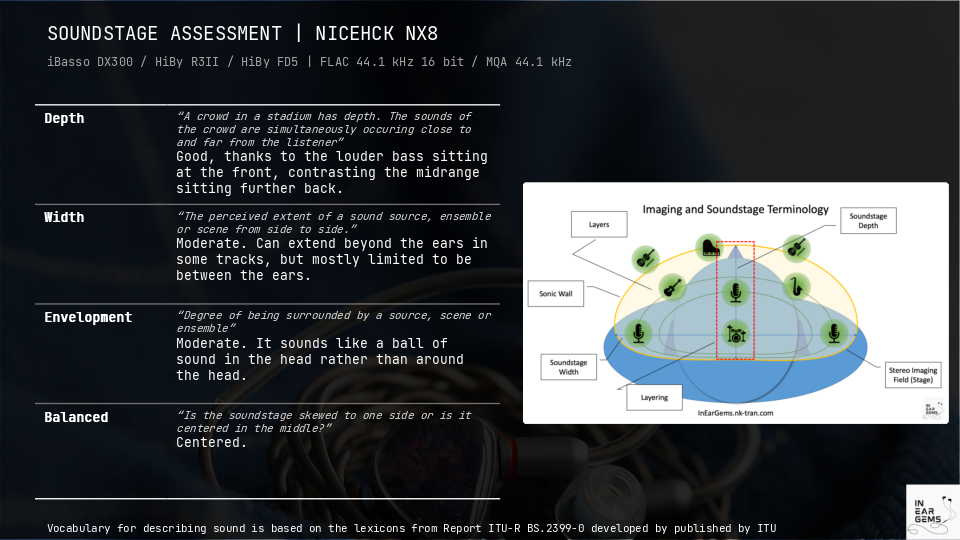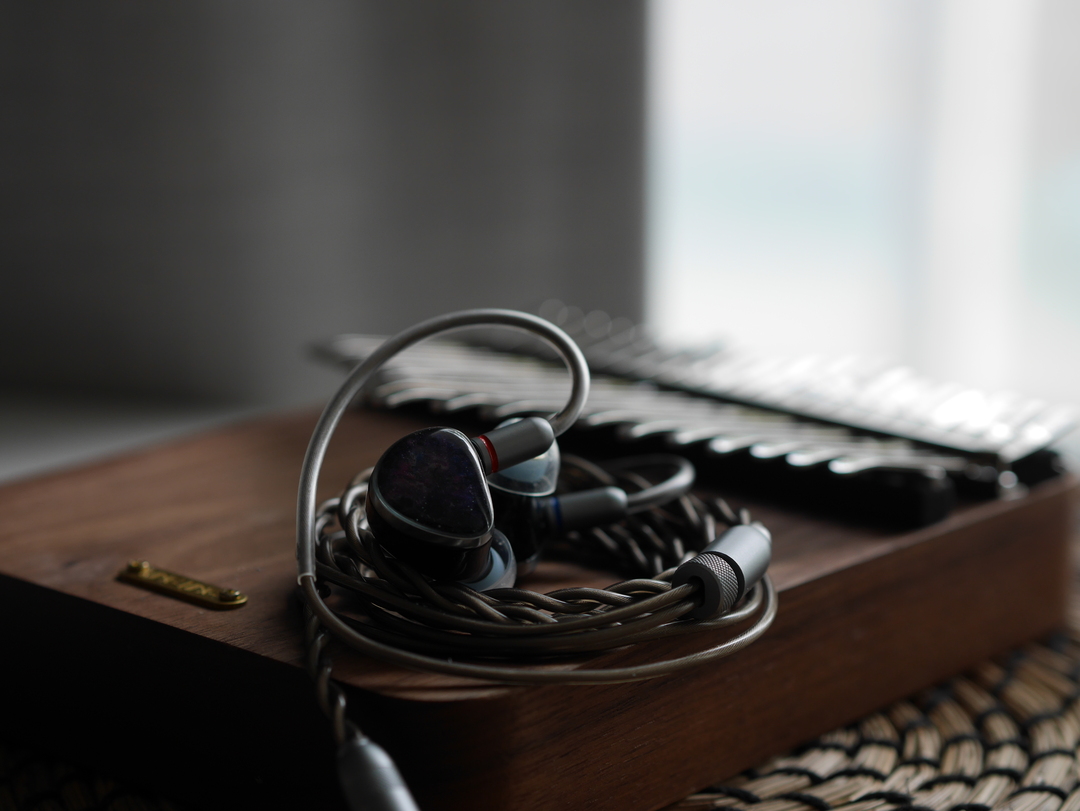NICEHCK NX8 - I heard you like bass
Today, we look at the flagship from the current line up of NiceHck, the tribrid NX8.
Forewords
- What I look for in an IEM is immersion. I want to feel the orchestra around my head, track individual instruments, and hear all of their textures and details. I’m not picky about tonality, as long as it does not make the orchestra, violin, cellos, and pianos sound wrong.
- I rate IEMs within with a consistent scale from 1 (Poor) to 3 (Good) to 5 (Outstanding). An overall ranking of 3/5 or above is considered positive.
- Ranking list and measurement database are on my IEM review blog.
- The terminology for subjective impressions in this review is based on the Audio Wheel for reproduced sound defined in the technical report ITU-R BS.2399-0
- This review is based on a review sample from NiceHck (Thank you!). I have no affiliation with or financial interest in NiceHck.
- The unit retails for $199 at the time this review was published. Unaffiliated link: NiceHck Web Store
General Information

Non-sound Aspects


My main impression of NX8 is that it is much smaller its online photos, which is particularly impressive given the number of drivers it packs. The combination of small shells, small nozzles, and the new silicone tips NiceHck C04 leads to a very comfortable wearing experience. My only nitpicking about the design of NX8 is the fact that the nice starry faceplates are actually printed plastic plates covered by a layer of clear coating. I find this cost cutting design element cheapen the nice design and build quality elsewhere on the earpieces.
Sonic Performance
Timbre:





NX8 does not deviate far from the success formula followed by various IEMs in 2024, with a warm-neutral with sub-bass boost sound signature. On both graph and cursory listening across genres, there are very little that I can fault NX8 in terms of tonality and tonal balance. However, closer listening to the midrange region leaves me wanting. Despite the tastefully boosted lower-midrange, I’m surprised to find that there is just a slight lack of richness in most voices and instruments, preventing them from achieving the same emotional response that I anticipated. I admit it’s rather nitpicking and would be hard to engineering a solution.
The treble of NX8 also has a … particular timbre to it. It’s not offensive or off-putting, and I found that I don’t notice it anymore after spending a few weeks with this IEM.
Percussion, Bass, and perceived dynamic:

The calling card of NX8 is the bass. Powerful, indulgent, and satisfying all around. Yes, NX8 does sacrifice a certain degree of tightness and control over bass transient to gain a stronger sense of impact, but ultimately, it’s quite rare for this IEM to be too “slow” for a bassline across my library.
Resolution:

Good, but not outstanding. NX8 never sounds particularly blunted or congested, and the detail retrieval in the treble region is commendable in sparse recordings. However, it’s not particularly resolving either.
Stereo imaging and soundstage:


Again, NX8 is good but not quite outstanding when it comes to stereo imaging and soundstage. The main advantage of NX8 is the sense of depth and the overall accuracy of localisation. However, the stage size of NX8 is only average in the realm of IEMs, thus nullifying some of its advantages.
Driveability
NX8 is relatively easy to drive. It requires a few extra volume notches compared to easy-to-drive IEMs like AFUL Performer5+2, but it’s not difficult enough to cause any problem for a small DAP like HiBy R3II. I did not hear substantial “scaling” when moving from smaller DAP to larger DAP and desktop DAC/amp setup besides a slight improvement in soundstage size.
Comparisons
Vs AFUL Performer5+2 (P7):
- Despite having identical graphs, NX8 sounds like a bass-focused IEM whilst P7 sounds more open and “lighter”.
- The midrange tonal balance of P7 and NX8 are nearly identical. That said, the timbre of the midrange of P7 and NX8 are different. I found that NX8 lacks some richness and density in the midrange. This phenomenon is particularly noticeable with cellos and male vocals.
- The bass of NX8 sounds thicker and with seemingly longer decay, whilst P7 sounds more “bouncy” and elastic. The amount of bass is quite similar, but the “slower” bass of NX8 makes it feels more bassy, if not slightly “bleeding” over the midrange.
- P7 has an advantage when it comes to overall clarity and detail retrieval.
- The soundstage of P7 spreads out more and feels more open than that of NX8.
Gallery






Conclusions
What I like about this IEM:
- Indulgent, thick bass response
- Comfortable fit due to small shells and small nozzles
- Good tonal balance and overall technical performance to complement the bass
What could be improved:
- The soundstage could be more spread out and open to take advantage of the good imaging
- Printed faceplates do not stand up well to closer inspection

